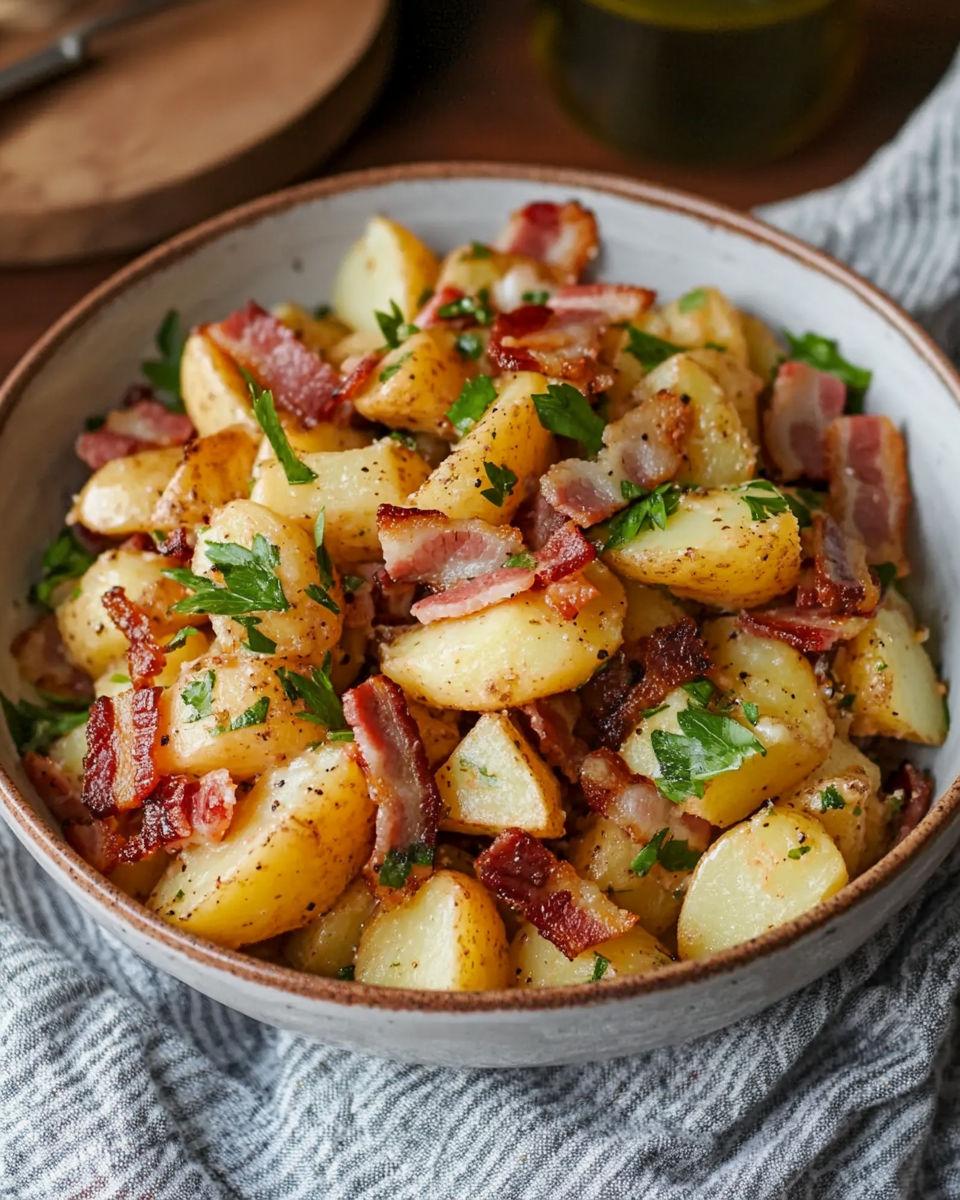A classic warm German potato salad featuring tender potatoes tossed in a tangy, slightly sweet vinaigrette with crispy bacon and fresh herbs. Perfect as a side dish for lunch or dinner, this salad combines comforting flavors with a bright zing.
FULL RECIPE
Ingredients
- 2 pounds (900g) small red or Yukon gold potatoes
- 6 slices bacon, diced
- 1 small yellow onion, finely chopped
- 1/4 cup apple cider vinegar
- 2 tablespoons granulated sugar
- 1 tablespoon Dijon mustard
- 1/2 teaspoon salt
- 1/4 teaspoon black pepper
- 1/4 cup fresh parsley, chopped
- 2 tablespoons olive oil (optional)
Directions
- Place potatoes in a large pot and cover with salted water. Bring to a boil and cook until tender when pierced with a fork, about 15-20 minutes. Drain and let cool slightly.
- While potatoes cook, fry bacon in a large skillet over medium heat until crispy. Remove bacon pieces with a slotted spoon and set aside, leaving the bacon fat in the pan.
- Add chopped onion to the bacon fat and sauté until translucent, about 3-4 minutes.
- In a small bowl, whisk together apple cider vinegar, sugar, Dijon mustard, salt, and pepper. Pour this mixture into the skillet with onions and cook for 1-2 minutes until slightly thickened.
- Slice the warm potatoes into halves or quarters and add them to the skillet. Toss gently to coat the potatoes in the warm dressing.
- Stir in the crispy bacon and parsley. Drizzle with olive oil if desired for extra richness.
- Serve warm or at room temperature.
Nutritional Information
- Calories: 220 kcal
- Protein: 5 g
- Carbohydrates: 27 g
- Dietary Fiber: 3 g
- Sugars: 5 g
- Fat: 9 g
- Saturated Fat: 3 g
- Cholesterol: 20 mg
- Sodium: 450 mg
History of German Potato Salad
German potato salad, known as “Kartoffelsalat” in Germany, has been a beloved traditional dish for centuries. Unlike the creamy, mayonnaise-based potato salads popular in the U.S., the German version is typically warm and features a tangy vinegar-based dressing. This style originated in southern Germany, particularly in Bavaria and Swabia, where potatoes were a staple crop. The salad was often served alongside hearty meals, especially during colder months, providing a comforting yet light accompaniment.
Regional Variations
Within Germany and beyond, variations of German potato salad reflect local tastes and ingredients. In northern Germany, the salad may include more herbs like dill or chives and sometimes pickles. The southern versions, especially from Bavaria, tend to be richer with the use of bacon and onions fried in bacon fat. American adaptations often blend both styles, adding mayonnaise or sour cream, but the authentic versions are predominantly warm and vinegar-based.
Flavor Profile
The hallmark of German potato salad is its bright, tangy flavor that balances the earthiness of potatoes. The vinegar provides acidity, while sugar adds a subtle sweetness that complements the savory bacon and caramelized onions. The interplay of warm potatoes with a slightly sweet and sour dressing creates a comforting yet refreshing taste experience. Fresh parsley adds an herbal brightness, rounding out the flavors perfectly.
Health Benefits of Potatoes
Potatoes are a nutritious and versatile vegetable rich in vitamins, minerals, and fiber. They are an excellent source of vitamin C, potassium, and vitamin B6, which support immune function, heart health, and metabolism. While often misunderstood due to their carbohydrate content, potatoes can be part of a balanced diet, especially when prepared with wholesome ingredients like those in German potato salad.
The Role of Bacon in the Salad
Bacon adds a smoky, salty depth to the salad that enhances its overall flavor. When cooked until crispy, bacon provides texture contrast and umami richness. It also contributes fat, which helps to mellow the acidity of the vinegar dressing. While bacon does add saturated fat and sodium, used in moderation, it makes the dish more indulgent and satisfying.
Why Vinegar is Key
Vinegar is essential to German potato salad’s distinctive tang. Apple cider vinegar is often preferred for its mild sweetness and fruity notes, which balance the saltiness and richness of the other ingredients. Vinegar also acts as a natural preservative, which historically helped keep the salad fresh for longer periods when refrigeration was less common.
Serving Suggestions
German potato salad is incredibly versatile and pairs well with many dishes. It is traditionally served as a side with sausages such as bratwurst, grilled meats, or schnitzel. It can also be a hearty addition to a picnic or barbecue spread. Some enjoy it as a light main dish accompanied by a green salad or crusty bread, especially when served warm.
Making It Ahead and Storage Tips
This salad can be made ahead of time and often tastes better the next day after the flavors have melded. However, since it is typically served warm, gently reheating it before serving helps restore its vibrant taste. Leftovers should be stored in an airtight container in the refrigerator for up to 3 days. Reheat carefully to avoid drying out the potatoes.
Common Mistakes to Avoid
One common mistake is overcooking the potatoes, which can make the salad mushy rather than tender yet firm. Using waxy potatoes like red or Yukon gold helps maintain texture. Another error is adding the dressing when potatoes are too cold; warm potatoes absorb the dressing better, creating a more flavorful salad. Balancing the vinegar and sugar is also crucial — too much of either can overpower the dish.
Nutritional Considerations
German potato salad offers a moderate calorie count with a good balance of carbohydrates, fats, and protein. It provides fiber from the potatoes and antioxidants from fresh herbs. While bacon adds saturated fat, the use of vinegar-based dressing keeps the dish lighter than creamy potato salads. For a healthier option, bacon can be reduced or replaced with smoked turkey bacon, and olive oil can be used instead of bacon fat.
Cultural Significance and Occasions
This salad holds a special place in German culture and is often prepared for family gatherings, holidays, and Oktoberfest celebrations. Its warm, comforting nature makes it a favorite during cooler months and festive events. Sharing German potato salad at a meal symbolizes hospitality and tradition, connecting generations through shared recipes and memories.
Tips for Customization
While classic recipes call for specific ingredients, German potato salad is adaptable to personal taste. Adding chopped hard-boiled eggs, pickles, or fresh herbs like chives can elevate the flavor. For a vegetarian version, omit bacon and use smoked paprika or mushrooms for umami depth. Adjust the vinegar and sugar quantities based on preference for more tang or sweetness.
Conclusion
German potato salad is a flavorful, warm, and tangy dish rooted in rich cultural tradition. Its unique vinegar-based dressing, combined with tender potatoes and savory bacon, creates a well-balanced and comforting side dish. With regional variations and customizable options, it remains a timeless favorite for many occasions. Whether served alongside grilled meats or enjoyed on its own, this salad offers a delicious taste of German culinary heritage.






